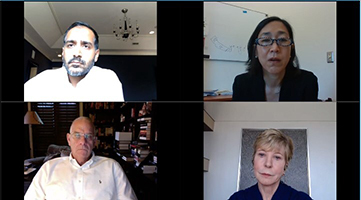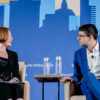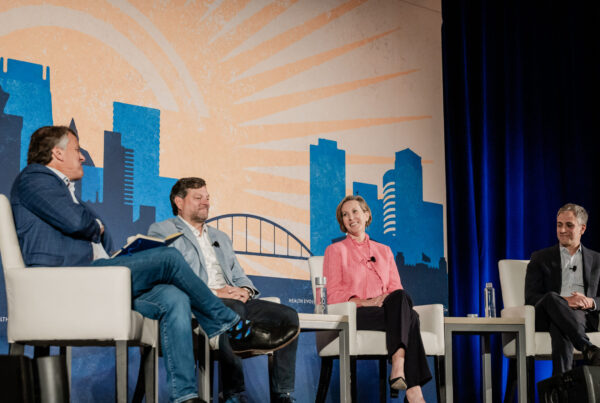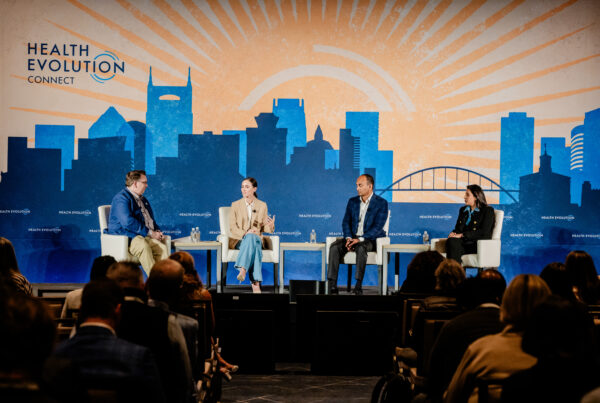Since the COVID-19 outbreak, health care as an industry has accelerated its pace of change beyond what was previously thought to be possible. And that spans providers, payers, federal and state governments as well as pharma and vaccine development.
“What we’ve seen is a breathtaking change in collaboration and operational transformation,” says Sachin Jain, MD, former President & CEO, CareMore.
Alice Chen, MD, Deputy Secretary for Policy and Planning and Chief of Clinical Affairs, California Health and Human Services Agency, added: “Change happens at the speed of trust. And it’s been really interesting because hospitals and pharma were very much in the hot seat — and they’re now our saviors in terms of being able to care for surge and develop therapeutics.”
Jain this week hosted the Health Evolution virtual gathering Leadership During a Crisis: Authenticity, Decision Making and Communication. Joining Jain and Chen were Peter Fine, President & CEO, Banner Health and Karen Ignagni, President & CEO, EmblemHealth.
This article examines the need for the following leadership attributes during a crisis, COVID-19 or otherwise:
-
-
- Honoring the humanity of the workforce
- Opening lines of communication as much as possible
- Following the science and data
- Taking a broader view of the industry
- Achieving vision beyond the crisis
-
Requisite leadership basics such as credibility, deep organizational knowledge, relationship building, transparency and trust, of course, set the foundation for strategies and tactics that are likewise always important but reach the height of criticality during a crisis.
Honoring the humanity of the workforce
Banner’s Fine recounted a phrase one of his mentor’s shared with him in the 1970s: “Visibility breeds credibility. Credibility breeds trust. If you want to be credible you better be visible.”
That is just as true during this pandemic when CEOs and other leaders are demanding considerably more of employees, while also increasing the risk with, for instance, the need to use PPE and masks more than once when interacting with infected patients.
Announcing: The Health Evolution CEO Guide to Artificial Intelligence in Health Care
To that end, Fine explained that more than two months ago he started recording weekly videos for Banner’s employee base. Some were inspirational, others educational or informational in nature, but all were designed to explain the heart of issues as best as Fine could at the time.
“At the beginning, I would get in the low thousands of people looking at them,” Fine said. “By the last one, about a week and a half ago, 35,000 employees were looking and you could tell the trust level was being built along the way.”
As a result, communication became greater, as did visibility into the challenges and work Banner is performing that employees might not otherwise clearly understand.
“I do a weekly video as well. And that has proven to be very important for employees to see you, hear you,” Ignagni said. “I even show a picture of the card table that I’m presently working on and the box my computer is sitting on. I live in a New York City apartment and nobody has a lot of room. I think that just encapsulates the fact that we are all in this together.”
Jain added that demonstrating the reality that employees are not alone is critical as everyone relies on health care organizations to deliver on their missions, and in a way that they never really have before.
“Honoring the humanity of the workforce, recognizing the unique challenges that everyone is facing right now, and presenting ourselves as people has just been so important to maintaining morale,” he said.
Opening lines of communication as much as possible
Many CEOs operate under the impression that the organization has established open communication lines, employees are aware of them and not hesitant to engage. That is all too often an imperfect representation of the truth — and it takes a strong leader to recognize when that should change.
Ignagni explained that EmblemHealth did not completely understand the concern that existed among its employees about re-entry, and how much they worried the organization would rush it. Most people have children that won’t be in school, camp or day care, so that is one issue, she noted. Another is that employees have to take mass transit to get to work.
“We wanted to get the word out early so last week we sent a note to all employees saying we have a four-phased re-entry. The earliest we would open sites of service for the non patient–facing parts of our enterprise is September 1,” Ignagni said. “People understand that we aren’t going to rush them onto a subway. We’re going to keep safety first.”
Chen noted that open lines of communication are also important outside the organization. Much of what California, and the nation, have been able to accomplish is rooted in preexisting discussions and relationships and now the challenge is how to engage with people in a trusting and respectful way to find common ground for the communities at large.
“The other pieces that have been critically important are being transparent, sharing data, keeping the lines of communication open for multiple stakeholders,” Chen said. “In a time of chaos people need direction. Even if we don’t know enough about COVID, to actually be able to communicate what we do know and the areas of uncertainty has been critical.”
Following the science
Science, data and what is factually understood about COVID-19 have been questioned — and, worse, politicized — since the outbreak’s very beginning.
“Science should be driving our thinking,” Fine said. “Whether we like it or not.”
Fine pointed to the alarming percentage of deaths from COVID that have happened in nursing homes as something that should be guiding our thinking.
See also: CEOs, policymakers discuss path out of COVID-19
With science and data evolving nearly every day, however, simply following it can prove challenging. Public health and epidemiologists did not have a complete picture of asymptomatic spread in February, as one example.
“The science changes,” Chen said. “When there is so much uncertainty, and we’re learning new things, it is challenging to be able to put that forward.”
Jain said that the health care CEO role extends beyond using science and data for decision making and into aggressively advocating for the government and other entities to also consider science to guide their courses of action.
Looking to science will be paramount when planning how to lift shelter-in-place restrictions because the last thing we want is to do so in a manner “that catapults us toward the scenario we’re trying to avoid to begin with,” Chen said.
Ignagni recommended that CEOs when communicating to policymakers, federal or state officials be transparent about what science reveals, what it cannot, and explain clearly what is driving conclusions. “Bring those learnings and that transparency and openness to state officials,” she said. “It’s important to do externally as you’re doing work internally.”
Taking a broader view of the industry
Health care has traditionally existed with adversarial lenses between different sectors but COVID-19 has essentially forced CEOs and top executives to take a step back and examine the bigger picture.
“Building that trust across sectors is something that we didn’t have before, but we now need it in spades as we look for solutions,” Jain said. “A broader view of the industry is so important.”
In EmblemHealth’s case, it has opened the doors of its health plan and determined where it can guide people find help outside its four walls, Ignagni said, whether that’s unemployment assistance, disparities, or directing people who no longer qualify for health insurance about where they can seek more information.
Fine added that CEOs need to think about how to transform the health care system. “The only way to transition is to change the basic component of this health care system, which, quite frankly, is reimbursement,” he said. “It’s an illogical approach and until you change how people are paid for the services they provide, it’s a problem.”
Pointing to the health care system overall and citing Medicare and Medicaid as specific examples as part of the reimbursement system, Fine said that no one would step up to a white board and intentionally design what exists today.
COVID’s sliver lining, perhaps, is the opportunity to accelerate change even more than has already happened during the pandemic.
“Trying to create a sense of urgency is the only way we will be able to actually do something,” Fine added. “Otherwise, we’re just playing around the fringes and modifying little bits and pieces of a system that doesn’t work.”
Achieving vision beyond the crisis
Forward thinking leaders are already considering not just how to endure the pandemic with operational sustainability but also how to emerge from the chaos and build a more equitable, cost-effective, patient-centered health care system.
“A lot of folks talk about this notion of going back to normal, but there probably is no going back to normal,” Jain said. “And so there’s this opportunity to not waste this crisis, to actually create and project a new normal and learn from these lessons.”
As a guiding principle, Chen pointed to e-consults and telehealth as long overdue in the safety net.
“It’s a bit of a shrug unless you put it in the context of a much bigger transformation. Particularly, video visits are just substitutes for an in–person visit,” Chen said. “But if you can couple it with population health, and registries, and data and an obligation and commitment to actually improving the health of your population, it can be an important tool.”
That’s just one example. Chen continued that as the nation thinks about supporting its health care system it will be important to do so in a manner that directionally shifts the focus to population health and population outcomes and away from near-countless individual transactions – and that is a completely different conversation and equation than has taken place to date.
See also: Health care leaders share biggest hopes, fears in COVID-19
“Now is an opportunity for hospitals, for health plans, for physician groups, for pharma, for device companies, and a whole range of others, public health experts, and advocates,” Ignagni said. “For different groups, who are situated in different organizations to come together and say, ‘Yes, we can work together on this. We can embrace it, and it’s important for the public.’ That could unite people from different sides of the political aisle because if there is any issue that’s in our national interest, it is public health and our safety right now.”
Conclusion
As the initial acute phases of COVID-19 start to wane, a number of questions will inevitably arise. What does public-private partnership look like? What are the roles and responsibilities of each? How does the industry move from a transaction-based system that spends $3.6 trillion to one that proactively invests in the health and wellness of populations? And how do CEOs and policymakers transition from a system cobbled together, with fragmented financing to a sense of mission?
And, even more pressing, how does the nation institute contact tracing, testing and vaccines to fortify the safety net and protect all Americans with a second, or even third, surge looming before herd immunity is established?
Those are indeed difficult, but necessary, questions to answer in the short-term — to which Fine reflected on another early leadership lesson that stuck throughout his career.
“When I was 26 years old an early boss said to me, ‘Peter, health care is a really tough business and you have to make difficult decisions, but make the right decision,’” Fine explained. “The right decision might get you fired but you have an obligation to think it through and make the right decision.”
To view an on-demand recording of this executive briefing, fill out this form:











